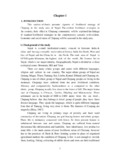Please use this identifier to cite or link to this item:
https://elibrary.tucl.edu.np/handle/123456789/3659| Title: | Livelihood Strategies of Chepang (A Case study of Shaktikhor VDC, Chitwan,Nepal) |
| Authors: | Sapkota, Mahesh |
| Keywords: | Household survey;Family planning;Drinking Water |
| Issue Date: | 2010 |
| Publisher: | Department of Rural Development |
| Institute Name: | Central Department of Rural Development |
| Level: | Masters |
| Abstract: | This thesis entitled "livelihood strategies of Chepang : A case study ofShaktikhor VDC Chitwan, Nepal". The generalobjectives of this study aretoanalyzethe livelihood practices of Chepang, to examine the Socio-cultural anddemographicalcharacteristics of Chepangand to find out the socio economiccondition of Chepang. Chepang of Shaktikhor VDC is miserable condition.Theyareback wardedin every sector. The study attempts to documents of thelivelihood strategies of Chepang andfuscous socio-economic and occupationalpattern in the study area. ShaktikhorVDC, situatedin the north part of the Chitwan. In this VDC,therewere 1160 households. In the study area 40 households are selected for therandom sampling from Shaktikhor,gairibari, Chepedhap, Chisapani, Kalika,Devitar and Neureni .The respondents are household head. Simple randomsampling techniques havebeen used to select the sample. In this study datawere colleted from field survey by applyinghousehold'ssurvey, questionnairesand observation methods. The study found that total 40 households areinterviewed reported that they had adopted agriculture as a main occupation.Average family size of the sampled households was 6.4 per households. Aboutthe 62.5% Chepang households are involving in agriculture as a mainoccupation. The total population of 40 households are 257 among them 129are male and 128 are female. Among the 40 respondent only 10% haveproduced adequetquantity of food grain, among the 40 respondents75% foundthe traditional houses and 25 found in modern. It was found that from study, 60% are illiterate, and now 90% of Chepang areinterested to send their Children toschooland out of the 40 respondents 7.5 %have permanent toilet where as 30% are temporary and 62.5% are none, and62.5% Havefacility of tap waterand 50% of the households had a 0.1 to10ropani land and estimated annual income is 20000 to 30000. The aboveanalysis is shows that Chepang community of Shaktikhor socially andeconomically deprives. It was found that, to improve the Livelihoods strategies of Chepang theretraditional typeof farmingsystem should be changed in to modern.Somesortof intensive type of farming scheme should be encouraged in this area. ‘JT’ and‘JTA’ must be sent for their help regularly, so that they could be convincedabout intensive type of farming and the implication of small farmer programwill be fruitful for uplift the Chepangs livelihood. Government should providesome low interest lone for livestock and agriculture production. Governmentshould be focused income generation activities, such as Goat farming, pigfarming, bee keeping, vegetable farming etc. They were not trained with anyvocational guidance or propertraining, for themobilization oflocal resourcesskill development training alsorequired them. |
| URI: | http://elibrary.tucl.edu.np/handle/123456789/3659 |
| Appears in Collections: | Rural Development |
Files in This Item:
| File | Description | Size | Format | |
|---|---|---|---|---|
| COVER.pdf | 30.24 kB | Adobe PDF |  View/Open | |
| CHAPTER.pdf | 228.81 kB | Adobe PDF |  View/Open |
Items in DSpace are protected by copyright, with all rights reserved, unless otherwise indicated.
